Bamboo, renowned for its eco-friendly nature, durability, and aesthetic appeal, is a popular choice for various interior products, including bath mats. However, do you know that bamboo bath mats can get moldy? And how to clean bamboo bath mat effectively?
In this article, we’ll delve into these questions, shedding light on the potential challenges of mold on bamboo bath mats and offering valuable tips to maintain and clean them effectively.
Contents
1. Bamboo bath mat pros and cons
Bamboo bath mats have become increasingly popular in recent years, admired for their natural aesthetic and perceived eco-friendliness. However, like any product, bamboo bath mats come with their own set of advantages and disadvantages.
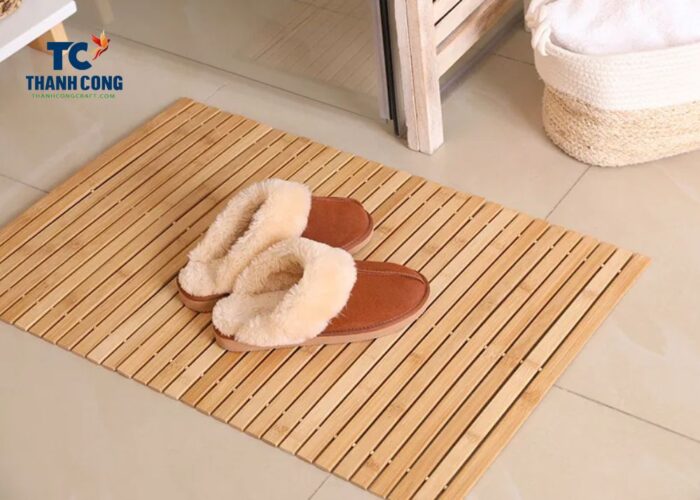
Here’s a closer look at the pros and cons:
1.1 Pros of Bamboo Bath Mats
- Eco-Friendly Material: Bamboo is a highly sustainable material. It grows rapidly, requires minimal water, and doesn’t need pesticides or herbicides, making bamboo bath mats an environmentally friendly choice.
- Durability: Bamboo is known for its strength and durability. Bamboo bath mats can withstand daily use and resist damage from moisture, providing long-lasting performance.
- Aesthetic Appeal: Bamboo bath mats add a touch of natural elegance to any bathroom. The warm tones and grain patterns of bamboo contribute to a visually pleasing and spa-like atmosphere.
- Water-Resistant: Bamboo has natural water-resistant properties, making bamboo bath mats resistant to water damage and mold growth if properly maintained.
- Easy Maintenance: Bamboo bath mats are relatively easy to clean. Regular sweeping or shaking off excess debris, coupled with occasional washing, helps maintain their appearance.
1.2 Cons of Bamboo Bath Mats
- Mold Susceptibility: Despite being water-resistant, bamboo bath mats can be susceptible to mold and mildew if not adequately dried between uses. This requires regular maintenance and proper ventilation.
- Scratching and Wear: While durable, bamboo bath mats may show signs of scratching or wear over time, especially in high-traffic areas. This can impact their appearance and longevity.
- Sensitivity to Moisture: Excessive moisture can lead to warping or cracking in bamboo bath mats. Placing them in consistently wet areas, such as directly in front of a shower, may accelerate wear.
- Price Range: Bamboo bath mats can be relatively more expensive compared to traditional bath mat materials. The initial investment may be higher, although some may argue that the durability justifies the cost.
- Limited Style Variations: While bamboo offers a unique and natural aesthetic, the style variations are somewhat limited compared to synthetic materials. This may be a drawback for those seeking diverse design options.
2. Do bamboo bath mats absorb water?
Bamboo bath mats, while possessing certain water-resistant qualities, have limitations. Bamboo inherently exhibits natural water-resistant properties and dries quickly, which is one reason why bamboo bath mats are favored in bathrooms. The surface of the bamboo is less porous than fabric, making it more resistant to water penetration.
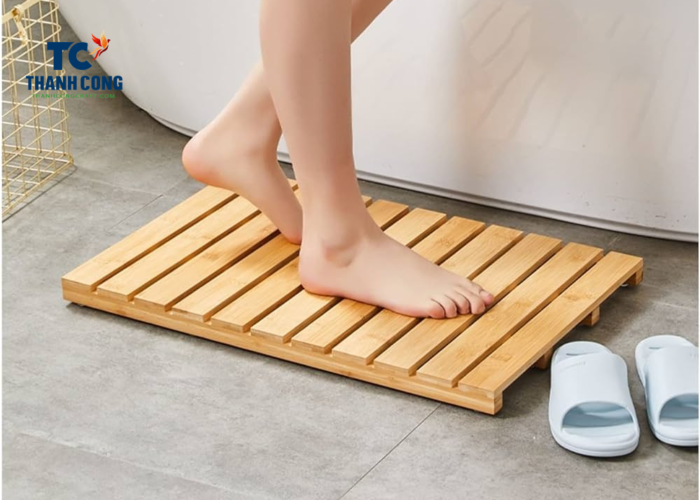
Some bamboo bath mats may be treated with coatings or finishes that enhance their water resistance. While this can provide additional protection, it may also influence the mat’s ability to absorb water.
The design of bamboo bath mats typically includes open slats or gaps between bamboo pieces. While this design allows for efficient water drainage and evaporation, it also means that the mat has limited direct contact with water, hindering its capacity to absorb moisture.
3. Do bamboo bath mats get moldy?
Bamboo bath mats, despite their natural water-resistant properties, can be susceptible to mold under certain conditions. Mold growth may occur if the mat is consistently exposed to moisture, lacks proper ventilation, or if it’s not adequately cleaned.
So, how do you get mold out of a bamboo mat? Here’s a guide on addressing mold on bamboo bath mats:
- Dry the Mat Thoroughly by removing the bamboo mat from the bathroom. Allow it to dry thoroughly in a well-ventilated area. Direct sunlight can also help inhibit mold growth.
- Brush Off Surface Mold, use a soft brush or cloth to gently brush off surface mold. Dispose of any loose mold particles in a sealed bag to prevent them from spreading.
- Mix equal parts white vinegar and water. Dampen a cloth or sponge with the solution and gently wipe the affected areas. Vinegar has natural antifungal properties and can help eliminate mold.
- For stubborn mold stains, make a paste using baking soda and water. Apply the paste to the affected areas and let it sit for some time before scrubbing with a brush or cloth.
- Mix a few drops of tea tree oil with water in a spray bottle. Spritz the solution on the moldy areas and let it sit for a while before wiping it off. Tea tree oil has antifungal properties.
- Ensure the bathroom is well-ventilated to promote drying. Regularly clean and dry the bamboo mat after each use. Consider rotating or flipping the mat to expose all sides to air and light.
Note: Always test cleaning solutions on a small, inconspicuous area of the bamboo mat to ensure they do not cause damage or discoloration.
4. How to clean bamboo bath mat?
Cleaning a bamboo bath mat is a simple process that, when done regularly, helps maintain its appearance and longevity. Follow these step-by-step instructions to clean your bamboo bath mat effectively:
Materials Needed:
- Mild dish soap;
- Soft brush or sponge;
- White vinegar;
- Water;
- Cloth or towel.
To clean a bamboo bath mat, you’ll need to prepare a basin of warm water, a small amount of soap or dishwashing liquid, a sponge or soft cloth, and a dry towel. Then, follow these steps:
Step 1: Remove the mat
Take the bamboo bath mat out of the bathroom and place it in a well-ventilated area. This allows for easier cleaning and thorough drying.
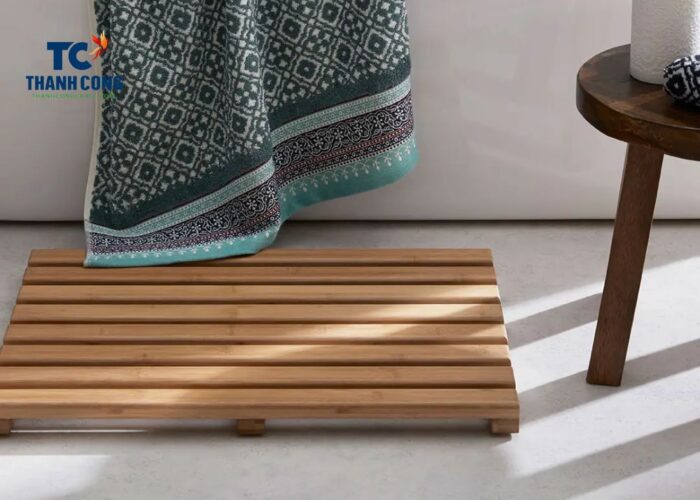
Step 2: Shake off debris
Gently shake the mat to remove loose dirt, debris, or hair. You can also use a soft brush to sweep away any particles trapped in the bamboo slats.
Step 3: Mix cleaning solution
In a bucket or basin, mix a solution of mild dish soap and water. Use a ratio of approximately 1 tablespoon of dish soap to 1 gallon of water.
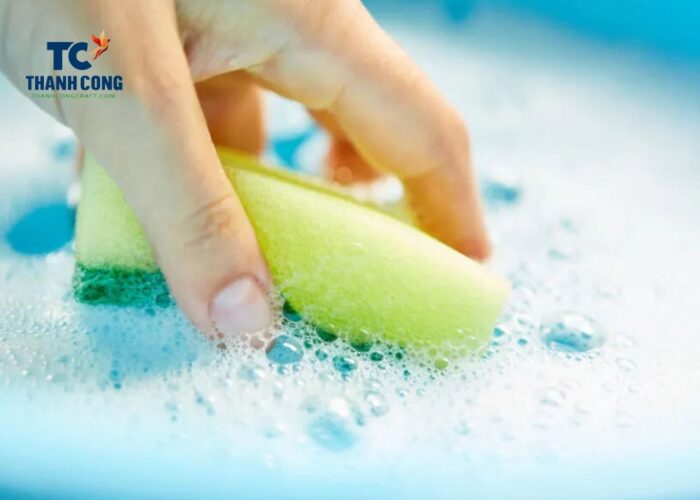
Step 4: Scrub the bamboo mat
Start to clean bamboo bath mat by dipping a soft brush or sponge into the soapy water mixture. Scrub the bamboo mat, paying extra attention to any stained or soiled areas. The gentle scrubbing helps remove surface dirt and stains.
Step 5: Rinse with water
Use a clean cloth or sponge dampened with plain water to rinse the mat thoroughly. Ensure that all soap residue is removed.
Step 6: White vinegar solution (Optional)
For additional disinfection and to inhibit mold growth, mix a solution of equal parts white vinegar and water. Dampen a cloth or sponge and wipe the entire surface of the bamboo mat.
Step 7: Dry your bamboo mat
Towel dry the bamboo mat to remove excess moisture. If possible, allow it to air-dry in sunlight. Sunlight helps prevent mold growth and maintains the mat’s freshness.
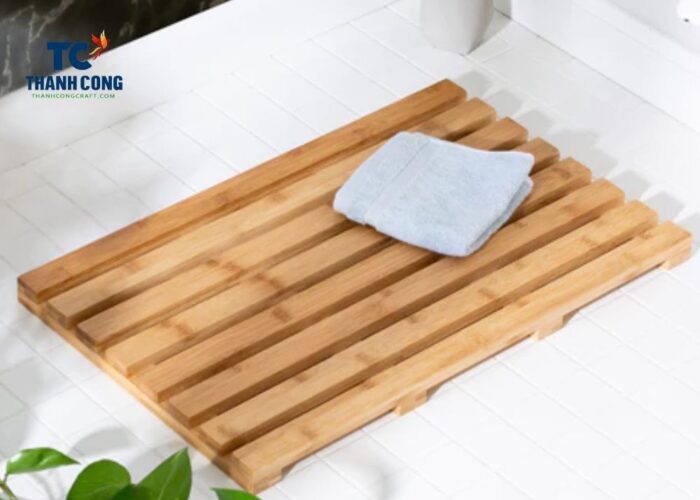
5. FAQs
5.1 What to put under bamboo bath mat?
Placing a protective layer underneath your bamboo bath mat is a good practice to prevent potential damage to the mat and the underlying surface. Here are some suggestions for what to put under a bamboo bath mat:
- Rubber or Silicone Rug Underlay:Using a rubber or silicone rug underlay provides a non-slip surface, preventing the bamboo mat from sliding around. It also acts as a barrier between the mat and the floor, protecting both surfaces.
- Non-Slip Rug Pad: Non-slip rug pads made of materials like latex or rubber can be placed under the bamboo bath mat. These pads offer grip, stability, and protection against moisture.
- Cork Shelf Liner: Cork shelf liners are moisture-resistant and provide a cushioning effect. Placing a cork liner under the bamboo mat can help protect the mat and the floor while enhancing slip resistance.
- Bamboo Bath Mat Tray: Consider placing the bamboo bath mat on a specialized bamboo bath mat tray. These trays often have elevated platforms that allow air circulation, preventing moisture accumulation beneath the mat.
- Towel or Cloth: If you don’t have a specific underlay, a folded towel or cloth can serve as a temporary solution. However, ensure that the towel is dry and changed regularly to prevent moisture retention.
- Ventilated Bath Mat Base: Some bamboo bath mats come with a ventilated base that elevates the mat, allowing air to circulate. This design helps prevent mold and mildew growth underneath the mat.
- Tile or Vinyl Flooring: If your bathroom has tile or vinyl flooring, placing the bamboo mat directly on the floor is generally safe. These surfaces are less prone to damage from moisture than wooden or carpeted floors.
5.2 How long do bamboo bath mats last?
The lifespan of a bamboo bath mat can vary based on factors such as usage, maintenance, and the overall quality of the mat. However, with proper care, a well-maintained bamboo bath mat can last for several years. Some factors that affect the lifespan of bamboo bath mats include:
- Quality of bamboo: Bamboo has different types, with different hardness, durability and mold resistance. You should choose bamboo bath mats made from high-quality bamboo, treated with anti-termite and anti-mold.
- Usage and storage: You should dry the bamboo bath mats after each use to avoid moisture and odor. You should also hang the bamboo bath mats in a well-ventilated place, away from direct sunlight and high temperature. You should not wash bamboo bath mats with a washing machine or dry them with a dryer, as this can damage the structure of bamboo.
- Frequency of use: If you use bamboo bath mats frequently, you should replace them at least once a year. If you use them less often, you can extend their lifespan up to two or three years
5.3 Are bamboo bath mats hygienic?
Yes, bamboo bath mats can be considered hygienic when properly maintained. Bamboo possesses natural properties that make it resistant to certain types of bacteria and fungi, contributing to a cleaner and more hygienic environment.
However, it’s essential to adhere to proper care and cleaning practices to ensure the hygiene of the bamboo bath mat. Some things you need to do to keep your bamboo bath mat clean are:
- Dry the mat after each use, avoiding water accumulation on the surface.
- Replace the bamboo bath mat at least once a month, or when you notice signs of mold or bacteria.
- Clean the bamboo bath mat by soaking it in warm water with a little vinegar or bleach, then rinse and dry well.
- Avoid exposing the bamboo bath mat to harsh chemicals, such as chlorine or ammonia, as they can damage the structure of the bamboo.
If you have any further questions about “how to clean bamboo bath mat“, don’t hesitate to send thanhcongcraft an email us at info@thanhcongcraft.com or directly contact us via Tel/WhatsApp: +84967485411. We are always ready to assist you!












